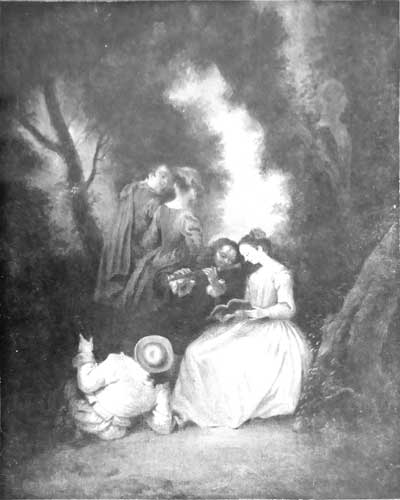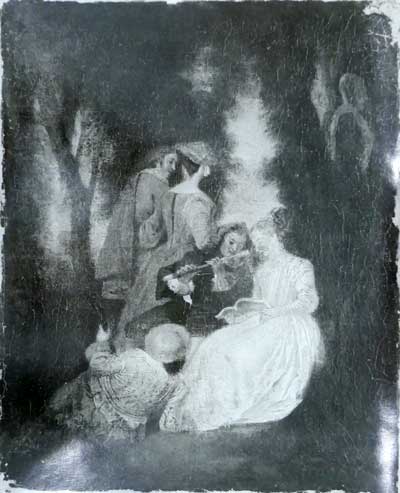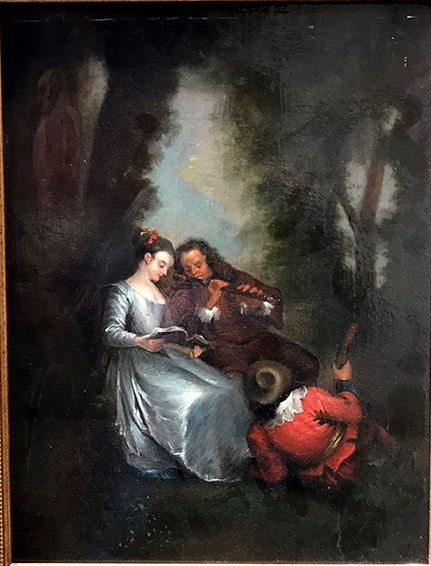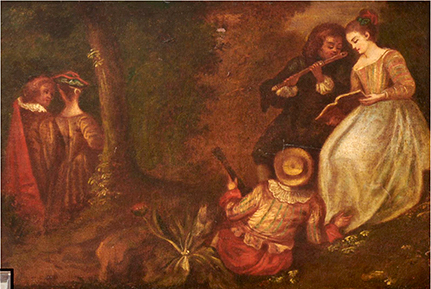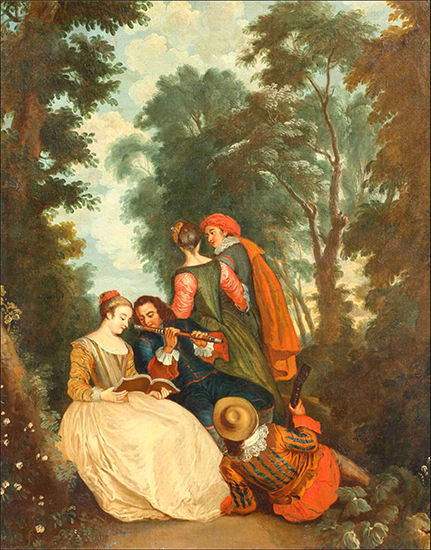
- Home Page
- Accepted
Paintings & Copies - Doubtful
Attributions - Doubtful Textual References
- Alternative
Titles - Collectors &
Museums - Bibliography
- Search Abecedario
- Watteau &
His Circle
L'Accord parfait (copy 1)
Entered March 2014; revised September 2025
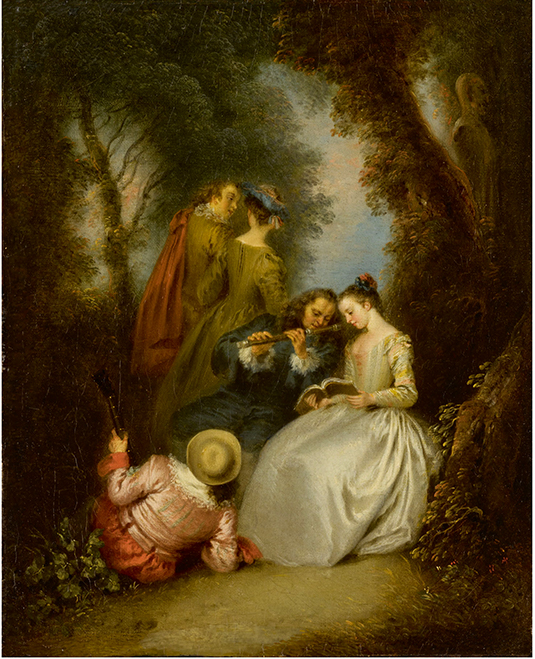
Whereabouts unknown
Oil on canvas
40 x 34 cm
ALTERNATIVE TITLES
A Pastoral Scene
Perfect Accord
Perfect Harmony
PROVENANCE
London, Christie’s, sale, July 12, 1879, property of a gentleman, lot 102: “WATTEAU. . . . Délassemens champêtres; a garden scene, with five figures, one playing the flute to a lady who holds the music, while another player is lounging on the ground in front. Engraved”. Sold to Woodcock, according to the firm’s annotated copy of the catalogue, now in the National Art Library, Victoria and Albert Museum.
New York, Gimpel and Wildenstein; sold after 1903 to William Salomon.
New York, collection of William Salomon (1852-1919; railroad executive and investment banker). His sale, New York, American Art Association, April 4-7, 1923, lot 377: “JEAN BAPTISTE JOSEPH PATER . . . A PASTORAL SCENE / (Canvas) / Height, 16 inches; width, 13½ inches / (Companion to the preceding) / A GROUP of five figures in a garden in summer time. Seated in the center under a tree, and wearing a white silk dress with white and pink corsage, is a young lady. She is holding a music score and turns to the right toward a blue-clad flute player; on the ground at her feet, and more to the left, is another musician, who, dressed in pink and holding his flageolet, has his back turned to the spectator. At the back, in the middle distance, is a young lady, in a bluish-yellow dress and wearing a blue hat, who is accompanied by a young gallant; he has a red cloak over his shoulder. They are about to walk away into the glade which is revealed in the right background.” The painting was supposedly sold to William Chester for $3,900 according to an annotated sale catalogue in the Frick Art Reference Library. One might well wonder if this was a legitimate sale since the picture appeared just a few years later in the 1928 auction of the collection of Salomon’s widow. The pendant, listed as lot 376 in the 1923 sale, was a copy after Watteau’s Le Conteur and it too was attributed to Pater.
New York, collection of Mrs. William Salomon (Helen Forbes Lewis, d. 1927). Her sale, New York, American Art Association, January 4-7, 1928, lot 764: “JEAN-BAPTISTE JOSEPH PATER . . . French: 1696-1736. . . A PASTORAL SCENE A group of five figures in a garden in summertime. Seated under a tree is a young lady in a white silk dress with pink and white corsage, holding a music score and turning towards a flautist at her right, clad in blue, who looks over her shoulder. On the ground at her feet is another musician in a rose doublet, holding a flageolet, his back turned to the spectator. Behind the group appears a young gallant cloaked in red, and accompanied by a young lady with a blue hat, who are strolling away from the spectator, into a glade. Height, 16 inches; width, 13 ½ inches. Purchased from Gimpel and Wildenstein [See illustration on page 245].” Sold for $6,100 to E. Rosenfield.
New York, Wildenstein and Co.; sold to the William Rockhill Nelson Gallery of Kansas City, MO, in 1934.
Kansas City, MO, William Rockhill Nelson Gallery of Art (later renamed the Nelson-Atkins Museum of Art); deaccessioned in 1986.
New York, Christie’s, January 15, 1986, lot 69: "JEAN BAPTISTE PATER . . . L’ACCORD PARFAIT, after Watteau / oil on canvas / 16¼ x 13½ in. (41.2 x 34.3 cm.) LITERATURE / J. Ingersoll-Smouse, Pater, 1928, p. 85, fig. 173 / $6,000-8,000.”
Paris, Galerie Segoura, attributed to Jean Baptiste Pater; sold in 1991 to Ezra and Cecile Zihlka.
New York, collection of Ezra Khedouri Zihka (1925-2019; financier) and Cecile Iny Zihlka (1932-2117). Their sale, New York, Sotheby’s, November 15, 2020, lot 63: “Jean-Baptiste Pater . . . L’Accord Parfait / oil on canvas / 16 by 13 3/8 in.; 40.5 x 34 cm . . Provenance With Gimpel & Wildenstein, New York / Where acquired by William Salomon, New York / His sale, New York, The American Art Association. / 4-7 January 1928, lot 764, where acquired by R. Rosenfeld / With Wildenstein & Co., New York. By whom sold to the Nelson Atkins Museum, Kansas City, Missouri in 1934 / By whom deaccessioned (“sold by Order of the University Trustees of the William Rockhill Nelson Trust, Kansas City, Missouri”) and sold, New York, Christie’s, 15 January 1986, lot 69 / With Galerie Segoura, Paris / There acquired in 1991 . . .
ENGRAVED C.-N. Cochin
Catalogue Note This charming fête galante epitomizes Pater’s elegant style and favorite subject matter. Using his distinctive feathery brushwork, with richly colored figures set against pale, misty backgrounds, he created depictions of a charmed and idealized rustic world. Here, elegantly clad figures lounge about in lush landscapes, with seemingly no cares, playing music, strolling through gardens and flirting with one another. His teacher, Jean-Antoine Watteau, created this genre and Pater successfully continued the tradition; indeed Pater copied a number of compositions by Watteau, the resent example included. [The original by Watteau is now in the Los Angeles County Museum of Art, inv. no. AC1999.18.1 . . . ]” Estimate: $60,000-80,000.
EXHIBITIONS
Springfield, Museum, Opening Exhibition (1933), cat. 61 (by Watteau, The Perfect Accord or Perfect Harmony [Painting after Watteau], lent by Wildenstein & Co.).
South Hadley, Mount Holyoke, The Eye Listens (1950), cat. 35 (by Pater, Perfect Harmony, lent by the William Rockhill Nelson Gallery of Art).
Kansas City, Nelson Gallery-Atkins Museum, Century of Mozart (1956), cat. 82 (by Pater, L'Accord Parfait).
New York, Wildenstein, Paris—New York (1977), cat. 47 (by Pater, L’Accord Parfait, lent by the Nelson Gallery-Atkins Museum, Kansas City).
SELECT BIBLIOGRAPHY
Ingersoll-Smouse, Pater (1928), cat. 594.
Kansas City, Nelson Collection (1940), 40, 46.
Kansas City, Nelson Collection (1949), 60.
Adhémar, Watteau (1950), under cat. 120.
Davies, French School (1957), 223, under cat. 2962.
Kansas City, Nelson-Atkins Museum, Handbook (1959), 261.
Macchia and Montagni, L’opera completa di Watteau (1968), under cat. 196.
Coe, “Baroque and Rococo” (1972), 538.
REMARKS
This copy appears to have been based directly on Watteau’s original painting and not the Baron engraving. The colors used by the copyist correspond to those of the picture now in Los Angeles.
In the nineteenth century, an age of unsophisticated, all-too-often positive attributions, this paintings and its pendant, a copy of Le Conteur, were given to Watteau himself. It was probably René Gimpel or Georges Wildenstein, recognizing that this claim was not sustainable, who lowered the attribution to Pater. The attribution to Pater was accepted by Ingersoll-Smouse, and apparently is still maintained today. Coe claimed that the copy was executed c. 1727 when it “passed from its first owner to Jean de Jullienne, who employed Pater as copyist.” Despite the prevailing tendency to ascribe copies after Watteau to Pater and other of his satellites, often documentary or visual justification, it is an artful dodge. There certainly is no documentation that Pater was employed by Jullienne as a copyist.
According to Ingersoll-Smouse, this picture was engraved by Charles Nicolas Cochin with slight differences in the background foliage. There is no such engraving by Cochin; see Roux, Fonds français (1930-77), 4: 594-661, esp. 603-09, cat. 31-47. Ingersoll-Smouse probably was referring to the engraving by Bernard Baron, although that print, after all, copies the painting now in Los Angeles.
This copy matches the colors seen in the original version, suggesting that it was copied directly from the original. The high quality of the copy should be noted.
L'Accord parfait (copy 2)
Entered March 2014; revised September 2025
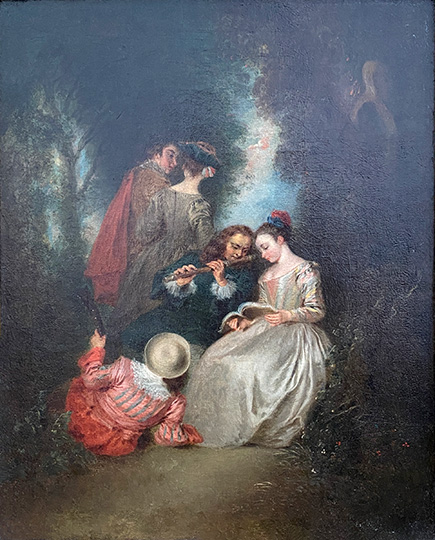
London, private collection
Oil on canvas
54.6 x 45.7 cm
ALTERNATIVE TITLES
A Musical Party
Perfect Harmony
PROVENANCE
London, collection of Cromartie Sutherland-Leveson, 4th duke of Sutherland (1851-1913). Cited in Catalogue of the Pictures in Stafford House (1898), cat. 76: “WATTEAU (ANTOINE.) Musical Party. Five Figures, a Gentleman playing the Flute.” Passed to a family member and descended within the family to the present owner.
SELECT BIBLIOGRAPHY
Staley, Watteau (1902), xi, 66.
Zimmermann, Watteau (1912), 137, 191.
Dacier, Vuaflart, and Hérold, Jean de Jullienne et les graveurs (1921-29), 3: cat. 23.
Réau, “Watteau” (1928), under cat. 118.
Adhémar, Watteau (1950), under cat.120.
Davies, French School (1957), 223, under cat. 2962.
Macchia and Montagni, L’opera completa di Watteau (1968), under cat. 196.
REMARKS
Although this painting was given to Watteau while in the Duke of Sutherland’s collection, most critics have been less optimistic. Goncourt thought this version “weak,” while Hannover and Zimmerman rightly considered it a copy. Dacier, Vuaflart, and Hérold evasively listed both the Edmond de Rothschild (now Waddesdon Manor) version and the Duke of Sutherland's versions as originals.
This copy matches the colors seen in the original version, suggesting that it was copied directly from the original. The high quality of the copy should be noted.
L'Accord parfait (copy 3)
Entered March 2014; revised May 2020
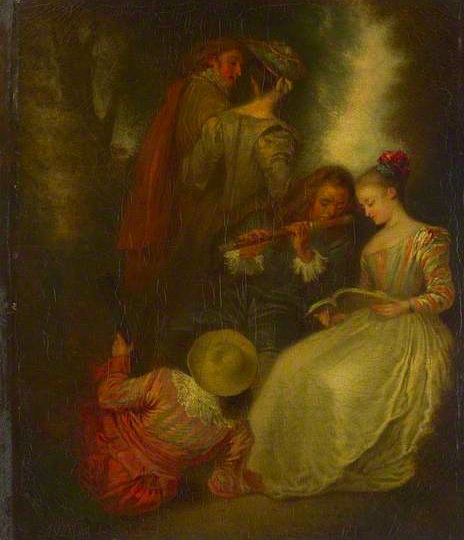
London, National Gallery, inv. NG 2962.
Oil on canvas
27.3 x 22.9 cm
ALTERNATIVE TITLES
Perfect Harmony
PROVENANCE
London, collection of Lord Henry Seymour. His sale, Paris, Hôtel Drouot, February 13-14, 1860, lot 126: WATTEAU . . . L’accord parfait. Gravé. H., 0,35 c; L., 0,28.” Bought by Van Cuyk for Sir Richard Wallace. The annotated copy of the catalogue in the Rijksbureau voor Kunsthistorische Documentatie has this lot selling for only 630 francs. In contrast, lot 113, which was listed under Pater’s name but was believed by buyers to be a Watteau, sold for 9,000 francs. Curiously, the annotated copy of the catalogue in the Frick Art Reference Library is annotated with the price and buyers’ names for almost all lots in the sale but not for L’Accord parfait, suggesting that Van Cuyk kept his mission secret.
Paris, collection of Sir Richard Wallace, 4th Marquess of Hertford (1818-1890). Bequeathed to his widow, Julie-Amélie-Charlotte Castelnau (1819-1897).
Paris, Lady Wallace collection. Mentioned in the Wallaces' rue Lafitte apartment in 1912 (see Ingamells, Hertford Mawson Letters, 389, no. 146). Bequeathed by her to Lord Wallace’s secretary, John Murray Scott.
London, collection of Sir John Murray Scott (1847-1912). Donated in 1914 to the National Gallery, London.
SELECT BIBLIOGRAPHY
London, National Gallery, Illustrations Continental Schools (1937), 395.
Davies, French School (1950), pl. 116.
Adhémar, Watteau (1950), under cat. 120.
Davies, French School (1957), 223, cat. 2962.
Ingamells, Hertford Mawson Letters (1981), 389.
London, National Gallery, Catalogue (1986), no. 2962.
Ingamells, Wallace Collection, French (1989), 389.
Jones, Fake (1990), no. 235.
Robert and Tupinier-Barrillon, "Galerie Seymour" (1999), cat. 139.
Vogtherr, Watteau at the Wallace Collection (2011), 144-45.
REMARKS
Presently there is agreement that this painting, once attributed to Watteau himself, is only a copy. As late as 1937 the National Gallery called it “studio of Watteau,” but even that claim has been modified since there is no reason to believe that it was done in Watteau’s shop. The 1986 catalogue describes it as a copy after Watteau. The colors of this version correspond to Watteau’s original painting as well as to several of the painted copies, suggesting that it was based on such a source and not the Baron engraving.
L'Accord parfait (copy 4)
Entered March 2014; revised September 2016
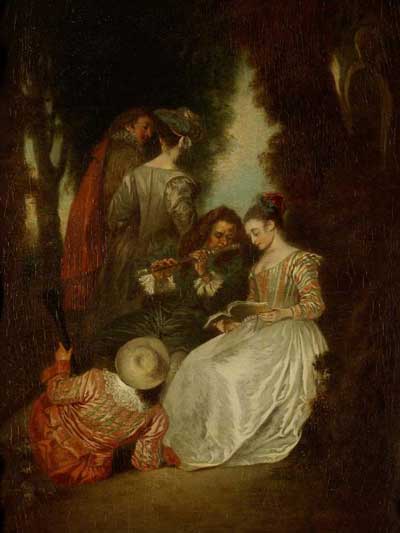
Waddesdon, Waddesdon Manor, inv. 2372.
Oil on panel
37.4 x 29.1 cm
ALTERNATIVE TITLES
Le Concert
Le Joueur de flûte
Perfect Accord
PROVENANCE
Paris, Baron James de Rothschild (1792-1868); by descent to his son, Edmond de Rothschild.
Paris, collection of Edmond de Rothschild (1845-1934); by descent to his son, James de Rothschild.
Waddesdon, Collection of James de Rothschild (1878-1957); bequeathed to Waddesdon, Rothschild Collection, in 1957.
SELECT BIBLIOGRAPHY
Zimmermann, Watteau (1912), 23, 181, under cat. 137.
Dacier, Vuaflart, and Hérold, Jean de Jullienne et les graveurs (1921-29), 3: under cat. 23.
Adhémar, Watteau (1950), cat. 120.
Davies, French School (1957), under cat. 2962.
“Munificent Rothschild Bequest” (1957), 41.
Levey, “French and Italian Pictures” (1959), 57.
REMARKS
According to various old paper labels on the back of the painting, the picture was inventoried at different times as Le Concert, Le Joueur de flûte, and L’Accord parfait. It presently is catalogued as The Perfect Accord.
Dacier, Vuaflart, and Hérold listed the Waddesdon picture (then still in the Paris collecton of Edmond de Rothschild) and the Duke of Sutherland's version as though both were originals by Watteau. Davies and Adhémar considered the Waddesdon version to be a copy of lesser quality.
X-rays taken by the Courtauld Institute in the 1950s revealed that this composition was painted over the top half of a still life with flowers.
L'Accord parfait (copy 5)
Entered March 2014; revised September 2016

Whereabouts unknown
Oil on canvas
38.1 x 30.5 cm
ALTERNATIVE TITLES
L’Intérieur d’un parc
PROVENANCE
Paris, sale, Verrier, LeRouge, etc., collections, March 12ff, 1782, lot 117: “IDEM. [ANTOINE WATTEAU] . . . L’intérieur d’un Parc, sur le devant duquel est une femme assise & tenant un livre de musique, pendant qu’un homme près d’elle l’accompagne avec sa flute: trois autres figures sont auprès d’eux. Le fond est terminé par des masses d’arbres. Hauteur 15 pouces, largeur 12 pouc. T.” Sold for 80.1 livres according to an annotated catalogue in the Bibliothèque nationale de France.
SELECT BIBLIOGRAPHY
Goncourt, Catalogue raisonné (1875), cat. 97.
Dacier, Vuaflart, and Hérold, Jean de Jullienne et les graveurs (1921-29), 3: cat. 23.
Réau, “Watteau” (1928), under cat. 118.
Adhémar, Watteau (1950), under cat. 120.
Macchia and Montagni, L’opera completa di Watteau (1968), under cat. 196.
REMARKS
Despite Edmond de Goncourt’s warning about the exemplars of L’Accord parfait sold in 1778 and 1782 (“La même composition, si ce n’est pas le même tableau . . .”), most twentieth-century scholars have
presumed that the two works were one and the same. Yet, while the painting sold in 1778 proves to be the autograph version by Watteau, now in the Getty Museum, there is reason to believe that the picture sold in March 1782 was only a copy. It differs from the original in two distinctive aspects. First, it is slightly larger. The original Watteau was measured at twelve by nine pouces or thirteen by ten pouces, whereas the 1782 picture was seemingly larger at fifteen by twelve pouces. Secondly, the authentic Watteau is on a wooden panel whereas the March 1782 picture was supposedly on canvas. Each of these differences might be considered sufficiently slight to overlook, but together they signal that caution should prevail. Moreover, and more damning, when the original version sold just four years earlier, it brought 930 livres. The canvas sold in March 1782 brought only 80.1 livres, a notably lower price. This is certainly not the proper price level for an authentic Watteau. The 1782 picture may be one of the many extant replicas, but it is not possible to identify which one.
Even though catalogued by Lebrun, who was generally a well-informed and reliable auctioneer, other lots in this same sale are also suspicious. The so-called Watteau listed as lot 116, Une Femme nue au bain, may well be one of many Pater scenes with bathing women that were sold under Watteau’s name in the eighteenth century.
L'Accord parfait (copy 6)
Entered March 2014; revised September 2016

Whereabouts unknown
Medium unknown
Measurements unknown
ALTERNATIVE TITLES
Concert champêtre
PROVENANCE
Paris, Place de la Bourse, anonymous sale, March 12-13, 1839, lot 45: “Le même [WATTEAU]. Concert champêtre: un homme joue de la flûte, assis près d’une jeune fille qui tient un cahier de musique; à ses pieds est placé un jeune homme tenant une guitare; derrrière eux un homme et une femme s’entretiennent ensemble.”
REMARKS
Given the lack of measurements and any indication of its provenance, it is impossible to identify this picture with any exactitude. Nonetheless, it is tempting to link it with the version of L’Accord parfait that was on the Paris market just ten years later, in 1849 (our copy 7).
L'Accord parfait (copy 7)
Entered March 2014; revised September 2016

Whereabouts unknown
Medium unknown
Measurements unknown
ALTERNATIVE TITLES
Concert dans un parc
PROVENANCE
Paris, place de la Bourse, anonymous sale, May 16, 1849, lot 26: “WATTEAU. Sujet du même genre [Le Concert dans un parc]. Dans ce charmant tableau, une jeune femme chante. Elle est accompagnée par un jeune homme sur la flûte; un troisième personnage assis à terre tient une mandoline; derrière, deux autres figures s’éloignent vers le fond du parc.”
REMARKS
Although Dacier, Vuaflart, and Hérold attached the provenance of Watteau's original version to this copy, this seems unlikely. Without measurements and provenance, the copy cannot be linked definitively with any of the other versions of the composition then in France. However, there is a good possibility it may have been the one sold in Paris in 1839 (our copy 6) and perhaps the one that later entered the collection of the Duke of Sutherland or James de Rothschild (our copies 2 and 4). These paintings lack provenances earlier than the mid-nineteenth century.
L'Accord parfait (copy 8)
Entered March 2014; revised September 2016

Whereabouts unknown
Oil on canvas
34 x 26 cm
ALTERNATIVE TITLES
Le Duo
SELECT BIBLIOGRAPHY
Ingersoll-Smouse, Pater (1928), cat. 595.
Adhémar, Watteau (1950), under cat. 120.
Davies, French School (1957), under cat. 2962.
Macchia and Montagni, L’opera completa di Watteau (1968), under cat. 196.
REMARKS
This copy after L’Accord parfait is so far untraceble. Ingersoll-Smouse referred to it with great specificity, as appearing in a London sale, March 25, 1926, lot 124, and described as Le Duo, attributed to Pater. Yet no appropriate auction catalogue has been located. Ingersoll-Smouse’s reference was repeated by Adhémar and by Macchia and Montagni. Adhémar added the name of a subsequent owner, “Murray,” yet she did not specify the owner's given name or city of residence, making it almost impossible to identify the person. Could she have meant Lord Murray of Edinburgh, the owner of Watteau’s Fêtes venitiennes? More probably she intended John Murray Scott, the owner of our copy 3, but that painting went to the National Gallery in 1914 and thus could not have been in the putative 1926 sale. Adhémar was often confused by American and English elements of provenance.
Ingersoll-Smouse vehemently declared, “Ce mauvais petit tableau n’est pas de Pater.” Although no image is available, it can be presumed that, provided that there was such a painting, it was just one of the many anonymous copies after Watteau’s composition.
L'Accord parfait (copy 9)
Entered March 2014; revised September 2016
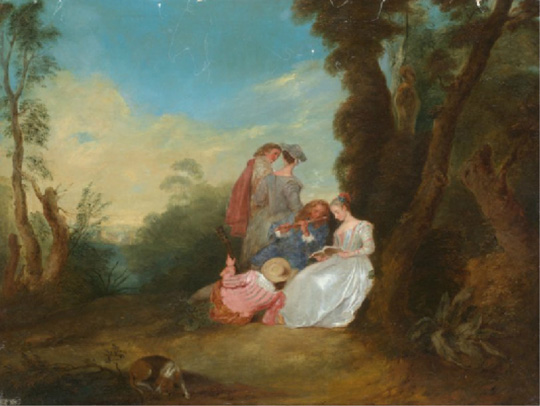
Whereabouts unknown
Oil on canvas
73 x 92 cm
ALTERNATIVE TITLES
Assemblée galante dans un parc
Musiciens dans un parc
PROVENANCE
Paris, Hôtel Drouot (Boisgirard), November 23, 2001, lot 6: “Philippe Mercier (1689-1760) Assemblée galante dans un parc / huile sur toile / 73 x 92 cm / €18 294 / 22 867 – 120.000/150.000 F / voir la reproduction ci-dessus.” Bought in.
Paris, Hôtel Drouot (SCP Digard Pestel-Debord), June 25, 2010, lot 42: “ECOLE FRANCAISE DU XIXe SIÈCLE, D’APRÈS JEAN ANTOINE WATTEAU / L ‘accord parfait Toile 73,5 x 92 cm Reprise avec variantes (présence d’un paysage élargi dans notre version) du tableau conservé dans une collection particulière à Londres (voir E. Camesasca, Tout l’oeuvre peint de Watteau, Paris, 1970, no 196, reproduit)." Bought in.
Paris, Hôtel Drouot (SCP Digard Pestel-Debord), November 30, 2011, lot 30: “ECOLE FRANCAISE du XIXe siècle, d’après Jean Antoine WATTEAU / L ‘accord parfait Toile 73,5 x 92 cm Reprise avec variantes (présence d’un paysage élargi dans notre version) du tableau conservé dans une collection particulière à Londres (voir E. Camesasca, Tout l’oeuvre peint de Watteau, Paris, 1970, no 196). “ Sold for €2,200 plus premium.
SELECT BIBLIOGRAPHY
Ferré, Watteau (1972), cat. P42.
REMARKS
This picture was catalogued by Ferré in 1972, seemingly as a Watteau but with no information about its provenance, measurements, etc. Although presented in 2001 as a work by Philippe Mercier, the painting has nothing in common with the style of that Watteau satellite. Its more recent description as an anonymous copy after Watteau is more appropriate. It is not a direct copy but an adaptation of L’Accord parfait that repeats the compacted group of five figures from Watteau’s composition but senselessly places them in an unrelated, extensive landscape setting. Although this picture does not preserve the integrity of Watteau’s composition, the costumes have essentially the same colors as those in the original and in several copies.
L'Accord parfait (copy 10)
Entered March 2014; revised September 2016
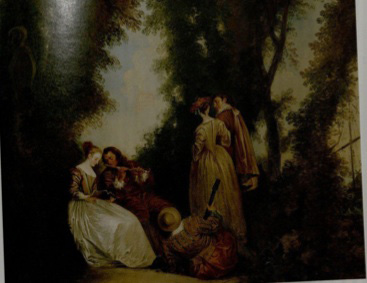
Whereabouts unknown
Oil on canvas
87.6 x 104.8 cm
ALTERNATIVE TITLES
L’Aubade dans le parc
Elegant Figures in a Park Playing Music
PROVENANCE
Paris, Hôtel Drouot-Montaigne (Ader Picard Tajan), April 25, 1989, lot 152: “François OCTAVIEN (Rome 1695-Paris 1736) / L’Aubade dans le parc / Toile / 87,5 x 105 cm. / 60 000 / 80 000.”
Paris, Galerie Delvaille, c. 1990-91, presented as a work of François Octavien.
New York, private collection.
New York, Sotheby’s, May 22, 1997, lot 89: “Attributed to Philip Mercier (1689-1760). ELEGANT FIGURES IN A PARK PLAYING MUSIC / oil on canvas / 34½ by 41¼ in. 87.6 by 104.8 cm. The present work relates to a composition, in reverse, of a painting by Antoine Watteau, now part of the Iveagh Bequest, Kenwood House, London $40,000-60,000.” Bought in.
New York, Sotheby’s, May 21, 1998 (“Property from an Estate”), lot 211: “Attributed to Philip Mercier (1689-1760) / ELEGANT FIGURES IN A PARK PLAYING MUSIC / oil on canvas / 34½ by 41¼ in. 87.6 by 104.8 cm. The present work relates to a composition, in reverse, of a painting by Antoine Watteau, now part of the Iveagh Bequest, Kenwood House, London. $20,000-30,000.” Sold for $25,300.
SELECT BIBLIOGRAPHY
Hayot, "Biennale des antiquaires" (1990), 54.
"Marché de l'art," L’Objet d’art (1991), 29.
REMARKS
Despite the attempted attributions to Octavien and Mercier, the picture shares nothing with those Watteau satellites. Instead, it is an adaptation of L’Accord parfait in which the elements of Watteau’s originally vertical landscape were reconfigured into a horizontal format, and the places of the five figures were shuffled to accommodate them to the new horizontal space.
L'Accord parfait (copy 11)
Entered March 2014; revised September 2016
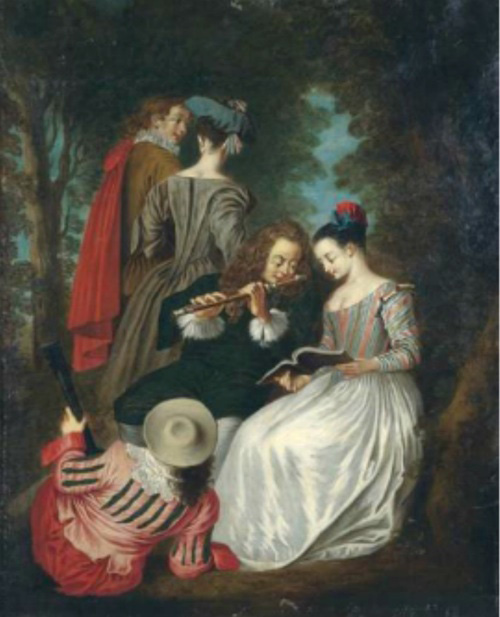
Whereabouts unknown
Oil on canvas
65.5 x 81 cm
PROVENANCE
Brussels, Cornette de Saint-Cyr, June 22, 2011, lot 66: “Ecole FRANCAISE du XVIIIème siècle, suiveur d’Antoine WATTEAU / L’accord parfait / Toile, agrandie dans la partie supérieure / 65,5 x 81 cm / Usures / Reprise du tableau d’Antoine Watteau conservé au Los Angeles County Museum of Art (Panneau de châtaignier, 35,5 x 28 cm), voir la catalogue de l’exposition Watteau et la fête galante, Valenciennes, musée des Beaux-Arts, 2004, reproduit fig. 56. / 3 000 / 4 000 €.” Bought in.
Brussels, Cornette de Saint-Cyr, December 14, 2011, lot 6: “Ecole FRANCAISE du XVIIIème siècle, suiveur d’Antoine WATTEAU / L’accord parfait Toile agrandie dans la partie supérieure 65,5 x 81 cm Usures Reprise du tableau d’Antoine Watteau conservé au Los Angeles County Museum of Art (Panneau de châtaignier, 35,5 x 28 cm), voir la catalogue de l’exposition Watteau et la fête galante, Valenciennes, Musée des Beaux-Arts, 2004.” Bought in, despite a lowered estimate of €2-3,000.
REMARKS
As the rendering of the faces reveals, the copyist responsible for this picture had a distinctive, somewhat unpleasant style.
L'Accord parfait (copy 12)
Entered March 2014; revised September 2016
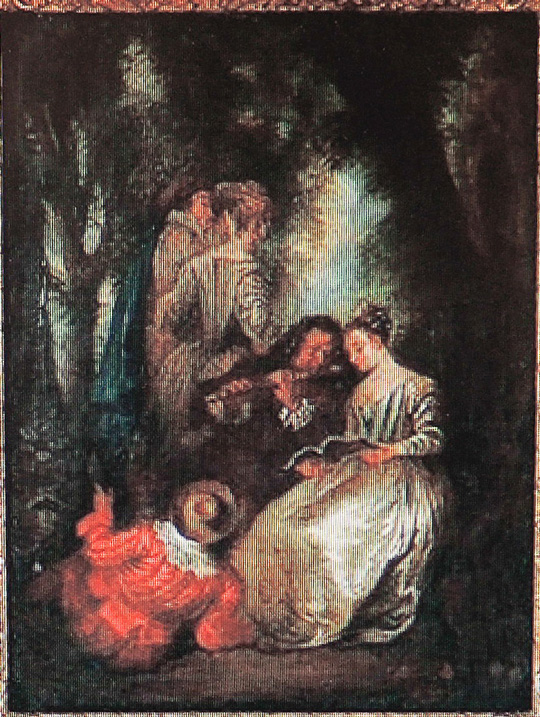
Whereabouts unknown
Oil on canvas
35 x 28 cm
ALTERNATIVE TITLES
Le Concert champêtre
PROVENANCE
Geneva, Hôtel des ventes, March 12, 2008, lot 1293: “Antoine Watteau . . . ,
école de. Le concert champêtre, huile sur toile, XIXe s., 35 x 28 cm. 3 000-4 000.”
Bought in.Paris, Hôtel Drouot (Millon & Associés), March 21, 2011, lot 83: “Ecole FRANCAISE du XVIIIe siècle, d’après Antoine WATTEAU / Le concert champêtre, dit l’accord parfait / Toile. 35 x 28 cm. / (Restaurations) / CT 1800 / 2200€ / Reprise d’une composition de Watteau conservée dans une collection particulière, Londres. (Ce lot est en importation temporaire).” Bought in.
L'Accord parfait (copy 13)
Entered March 2014; revised September 2016
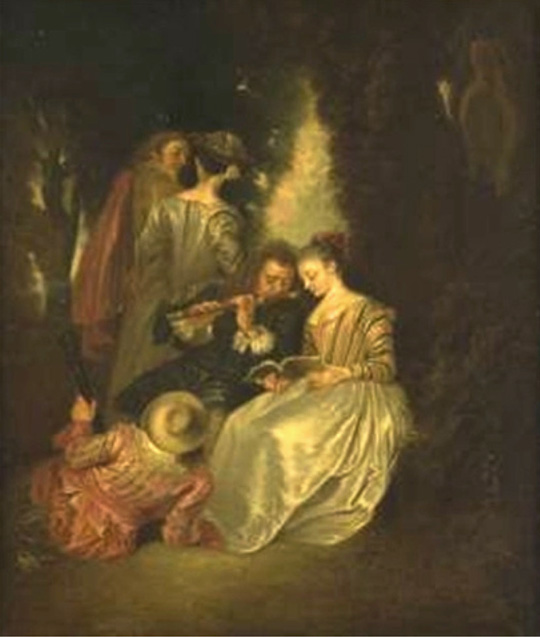
Whereabouts unknown
Oil on canvas
55 x 45 cm
PROVENANCE
Naples, Casa d’Aste Blindarte, May 20, 2008, lot 27, as by a follower of Jean Antoine Watteau. Estimated at €3,000-4,000. Bought in.
REMARKS
Despite the claim that this picture was signed (with Watteau's name?), the work is but a copy.
L'Accord parfait (copy 14)
Entered March 2014; revised September 2016

Whereabouts unknown
Materials unknown
Measurements unknown
PROVENANCE
Paris, collection of Victor Alvin-Beaumont (b. 1862; artist, dealer, critic), c. 1930-50.
SELECT BIBLIOGRAPHY
Adhémar, Watteau (1950), under cat. 120.
Macchia and Montagni, L’opera completa di Watteau (1968), under cat. 196.
REMARKS
Adhémar is the only scholar to refer to this version of L’Accord parfait (except that, as always, her text was subsequently parroted by Macchia and Montagni). Unfortunately, she gave no information about the picture, neither its size nor medium. Alvin-Beaumont published some of his Watteau pictures in his polemical writings on the artist, but he seems not to have presented this work publicly. Conceivably, his version is one that we have catalogued here separately.
L'Accord parfait (copy 15)
Entered July 2014; revised August 2015

Whereabouts unknown
Oil on canvas, or paper mounted on canvas
34.5 x 27.5 cm
PROVENANCE
Paris, Hôtel Drouot, February 16, 1981, lot 119: “WATTEAU (École d’Antoine) . . . L’ACCORD PARFAIT. Toile. (Peut-être papier marouflé). Cadre en bois sculpté. Haut. 0,345 m; Larg. 0,275 m. Répétition ancienne du tableau de Watteau.”
REMARKS
Despite its relatively recent appearance on the art market, no image of the painting is available.
L'Accord parfait (copy 16)
Entered November 2015
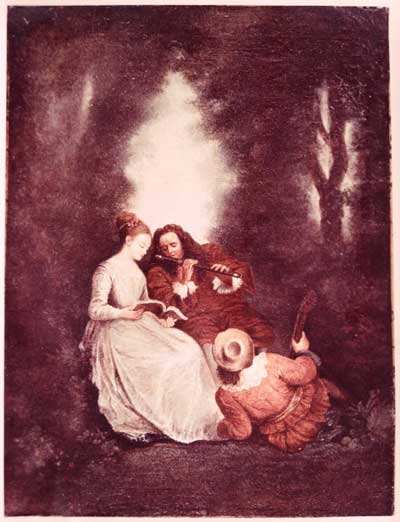
Whereabouts unknown
Oil on canvas
40.5 x 30.7 cm
PROVENANCE
Modena, collection of Alceste Giacomazzi, c. 1957.
REMARKS
This copy of Watteau’s composition, painted after Baron’s engraving, is known through a discolored photograph and correspondence on file at the Service de documentation, Département des peintures, Musée du Louvre.
L'Accord parfait (copy 17)
Entered February 2017; revised October 2019
Whereabouts unknown
Oil on canvas
46 x 37 cm
PROVENANCE
Versailles, Palais des congrès, December 8, 1968, lot 23: “MERCIER Philippe / (1689-1760) / LES MUSICIENS. Deux musiciens accompagnent à la flûte une jeune chanteuse, tandis que derrière eux deux personnages épris l'un de l'autre s'enfoncent dans les bois. / Peinture sur toile, dans un cadre ancien. / Haut. : 37 cm – Larg. : 46 cm. / (Voir la reproduction ci-contre)”
REMARKS
Although it was erroniously presented as work of Philippe Mercier, this picture is just another anonymous copy after Watteau. The 1968 sale catalogue transposed the dimensions.
L'Accord parfait (copy 18)
Entered February 2017
Whereabouts unknown
Oil on canvas
Measurements unknown
REMARKS
This picture is known to me through a photograph in the Getty Research Institute. The photo bears no annotations regarding size, provenance, or attribution. The many losses of paint around the edges as well as in the main field reveal all too clearly its poor condition.
L'Accord parfait (copy 19)
Entered September 2017

Whereabouts unknown
Medium unknown
Measurements unknown
PROVENANCE
Paris, Hôtel des ventes mobilières, sale, April 9, 1846, lot 4: “DU MÊME (Genre). [WATTEAU (ANTOINE)] . . . L’accord parfait: composition gracieuse et d’une belle couleur.”
REMARKS
When this painting appeared at auction in 1846, it was listed under the title of the Julienne engraving. However, it was also recognized that this was not the original from Watteau’s hand. As the picture was not described nor were its measurements given, it is not possible to link this painting with any of the other extant copies.
L'Accord parfait (copy 20)
Entered May 2019
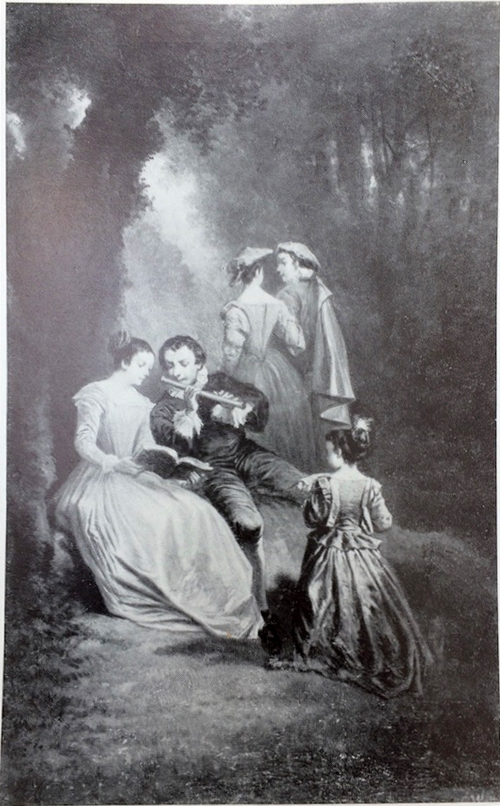
Whereabouts unknown
Oil on canvas
64 x 40 cm
ALTERNATIVE TITLES
Das Flötenkonzert
PROVENANCE
Bern, Galerie Dobiaschofsky Bern, sale, May 17-18, 1973, lot 217: “FRANZÖSISCHE SCHULE um 1850. Das Flötenkonzert. In Waldlichtung unter Baum sitzendes Mädchen in langem, seidenem Gewand, ein Notenbuch haltend, neben ihr Jüngling, eine Querflöte spielend. Vor den beiden mit dem Rücke gegen den Beschauer kleines Mädchen in langem, blauem Gewand, im Mittelgrund prominierendes Paar. Oel auf rent. Lwd, 64 x 40 cm / Hubsches Genrestück in der Nachfolge Watteau’s. Die Signatur unter rechts ist spätere Zutat. Kleine Restaurierstellen oben rechts. Siehe Abbildung, Tafel 19.”
REMARKS
The copyist worked from Baron’s engraving after L’Accord parfait, and changed several features: he omitted the lutenist on the ground and added the figure of a young girl who does not appear in Watteau’s original design. An attribution of this work to the 19th century seems well justified.
L'Accord parfait (copy 21)
Whereabouts unknown
Oil on panel
36 x 29.5 cm
ALTERNATIVE TITLES
Le Concert champêtre
PROVENANCE
Sale, Lille, Mercier et compagnie, March 28, 2020, lot 407: École française du XIXème siècle dans le goût du XVIIIème siècle. “Le Concert champêtre” panneau, 38 x 29.5 cm, estimation 200-400€.
REMARKS
This picture is based on Baron’s engraving and repeats only the three principal characters: the flutist, the woman singing, and the guitarist on the ground. Although of undistinguished quality, it follows the general dimensions of Watteau’s painting and the more faithful copies.
L'Accord parfait (copy 22)
Whereabouts unknown
Oil on canvas
35 x 59 cm
ALTERNATIVE TITLES
Concert dans un parc
PROVENANCE
Paris, sale, Hôtel Drouot (Pescheteau-Badin),,September 22, 2020, lot 26: “Ecole FRANÇAISE du XVIIIème, suiveur de Watteau / Concert dans un parc, au dos un blazon armorié / Toile / 31 x 58 cm / Restaurations anciennes. 400/600 ‹€.”
REMARKS
Although in the same direction as Watteau’s painting, the figures are distributed quite differently. In the same sale were a pair of copies after Lancret (lot 25) that have the same dark brown “patina” intended to convey a sense of age to the works.
L'Accord parfait (copy 23)
Whereabouts unknown
Oil on canvas
90 x 71 cm
ALTERNATIVE TITLES
Musiciens dans un parc
PROVENANCE
Château des Aspras (Var).
Cannes, Cannes Enchères. sale, October 16, 2020, lot 246: “Ecole FRANÇAISE du XIXème siècle, dans le goût de WATTEAU. Musiciens dans le parc. Toile. 90 x 71 cm (rentoilé). Provenance: Château des Aspras (Var).” est. 700-1,000 €.
REMARKS
This copy, based on Bernard Baron’s engraving after L’Accord parfait, is approximately 2.5 times the size of Watteau’s original painting but is not proportionately better. The rendering of the trees suggest that it is nineteenth century or later in origin.
